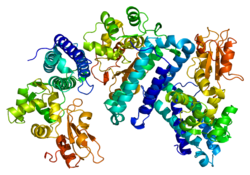
CBL (gene)
Cbl (named after Casitas B-lineage Lymphoma) is a mammalian gene encoding the protein CBL which is an E3 ubiquitin-protein ligase involved in cell signalling and protein ubiquitination. Mutations to this gene have been implicated in a number of human cancers, particularly acute myeloid leukaemia.
Discovery
In 1989 a virally encoded portion of the chromosomal mouse Cbl gene was the first member of the Cbl family to be discovered and was named v-Cbl to distinguish it from normal mouse c-Cbl. The virus used in the experiment was a mouse-tropic strain of Murine leukemia virus isolated from the brain of a mouse captured at Lake Casitas, California known as Cas-Br-M, and was found to have excised approximately a third of the original c-Cbl gene from a mouse into which it was injected. Sequencing revealed that the portion carried by the retrovirus encoded a tyrosine kinase binding domain, and that this was the oncogenic form as retroviruses carrying full-length c-Cbl did not induce tumor formation. The resultant transformed retrovirus was found to consistently induce a type of pre-B lymphoma, known as Casitas B-lineage lymphoma, in infected mice.
Structure
Full length c-Cbl has been found to consist of several regions encoding for functionally distinct protein domains:
- N-terminal tyrosine kinase binding domain (TKB domain): determines the protein which it can bind to
- RING finger domain motif: recruits enzymes involved in ubiquitination
- Proline-rich region: the site of interaction between Cbl and cytosolic proteins involved in Cbl's adaptor functions
- C-terminal ubiquitin-associated domain (UBA domain): the site of ubiquitin binding
This domain structure and the tyrosine and serine-rich content of the protein product is typical of an "adaptor molecule" used in cell signalling pathways.
Homologues
Three mammalian homologues have been characterized, which all differ in their ability to function as adaptor proteins due to the differing lengths of their C-terminal UBA domains:
- c-Cbl: ubiquitously expressed, 906 and 913 amino acids in length in humans and mice respectively
- Cbl-b: ubiquitously expressed, 982 amino acids long.
- Cbl-c: lacks the UBA domain and is therefore only 474 amino acids in length. It is primarily expressed in epithelial cells however its function is poorly understood.
Both c-Cbl and Cbl-b have orthologues in D. melanogaster (D-Cbl) and C. elegans (Sli-1), hinting at a long evolutionary path for these proteins.
Function
Ubiquitin ligase
Ubiquitination is the process of chemically attaching ubiquitin monomers to a protein, thereby targeting it for degradation. As this is a multi-step process, several different enzymes are involved, the final one being a member of the E3 family of ligases. Cbl functions as an E3 ligase, and therefore is able to catalyse the formation of a covalent bond between ubiquitin and Cbl's protein substrate - typically a receptor tyrosine kinase. The RING-finger domain mediates this transfer, however like other E3 ligases of the RING type no intermediate covalent bond is formed between ubiquitin and the RING-finger domain. The stepwise attachment of ubiquitin to the substrate receptor tyrosine kinase can lead to its removal from the plasma membrane and subsequent trafficking to the lysosome for degradation.
Interactions
Cbl gene has been shown to interact with:
Further reading
- Smit L, Borst J (1997). "The Cbl family of signal transduction molecules". Crit Rev Oncog. 8 (4): 359–79. doi:10.1615/critrevoncog.v8.i4.50. PMID 9622055.
- Lupher ML, Andoniou CE, Bonita D, Miyake S, Band H (1998). "The c-Cbl oncoprotein". Int. J. Biochem. Cell Biol. 30 (4): 439–44. doi:10.1016/S1357-2725(97)00075-7. PMID 9675877.
- Fang N, Fang D, Wang HY, Altman A, Liu YC (2002). "Regulation of immune responses by E3 ubiquitin-protein ligases". Curr. Dir. Autoimmun. Current Directions in Autoimmunity. 5: 161–75. doi:10.1159/000060552. ISBN 3-8055-7308-1. PMID 11826757.
External links
- Quips article describing CBL function at PDBe
- OMIM entries on NOONAN SYNDROME-LIKE DISORDER WITH OR WITHOUT JUVENILE MYELOMONOCYTIC LEUKEMIA and CBL
- Human CBL genome location and CBL gene details page in the UCSC Genome Browser.
|
PDB gallery
| |
|---|---|
| Ligand |
|
||||||||||||||||||||||||||||||||
|---|---|---|---|---|---|---|---|---|---|---|---|---|---|---|---|---|---|---|---|---|---|---|---|---|---|---|---|---|---|---|---|---|---|
| Receptor |
|
||||||||||||||||||||||||||||||||
| Intracellular signaling P+Ps |
|
||||||||||||||||||||||||||||||||
| Nucleus |
|
||||||||||||||||||||||||||||||||
| Mitochondrion |
|
||||||||||||||||||||||||||||||||
| Other/ungrouped | |||||||||||||||||||||||||||||||||
|
Chaperones/ protein folding |
|
||||
|---|---|---|---|---|---|
| Protein targeting | |||||
|
Ubiquitin (ubiquitylation) |
|||||
|
Ubiquitin-like proteins (UBL) |
|
||||










